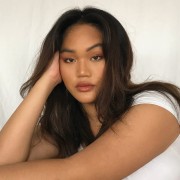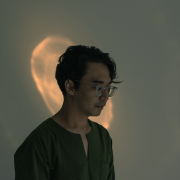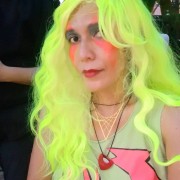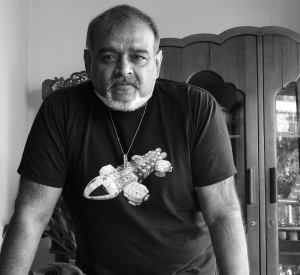Alya Hatta (B.1999)
Alya Hatta’s multicoloured paintings take us to moments that are personal to her. Currently taking her Master’s degree in painting at the Royal College of Art, most of the scenes depicted are of her life in London for the past 5 years. Thus, the questions of displacement, diaspora, and representation of her Asian identity are often addressed. In fact, the title of the series itself, ‘Always Greener’ (2021) draws from the famous saying that “the grass is always greener on the other side”, referring to her own migration to a foreign land. Dialoguing with her large-scale paintings are tiny canvas paintings which are stretched onto found objects such as a Panadol packaging, breaking the myth of what a painting should be. Alya’s attempt in expressing personal experiences and the notion of secrecy also gives birth to a set of small and intimate pencil drawings on paper. For the first time, we see Alya’s personage occupying the physical space of the audience in the form of a soft sculpture. With features that reflect the stereotypical appearance of an Asian woman, her body appears deconstructed and displaced.
Click to view CV.
Anwar Suhaimi (B.1987)
Anwar Suhaimi presents a series of monochromatic drawings executed by his self-built drawing robot, as the result of an experiment using physical computing technology, which he programmed to read instructions. This concept strongly echoes Anwar’s overall practice which, with his background in Fine Arts and Technology, has always seen him manoeuvre between both worlds. Anwar digitally sketched the shape of a water tank, followed by programming his device to draw the exact same forms. The duality between what is machine-programmed and organic is yet again present through the imperfections of the lines despite it being executed using technology. ‘The Water Tanks’ (2021) series could be considered as a continuation of his past installation work Delan (Ripplings) (2019), which received the Jury Award in Bakat Muda Sezaman 2019. This time around, he challenges our manner of looking at a public utilitarian object. Drawing the water tank’s different facades and layers, Anwar suggests the idea of it being an echo chamber; although a collective facility, one could only speculate what lies inside. Accompanying the drawings is a one-channel video unveiling the structure of the tank, realised using 3D modelling.
Click to view CV.
Shika (B.1976)
Pixel art started to gain relevance in the 1970s with the emergence of computers and digital art. Shika’s fascination towards this phenomenon as well as the rise of the internet culture inspired her to use it as a tool of activism, mainly addressing the issue of transphobia. What is even stronger is her attempt of combining both the digital and physical space, through the act of printing and pasting her pixel art onto canvas. QR codes are also embedded onto these collages, so as to bridge visitors to the virtual realm. Throughout the mentorship, Shika focused on the research of colours and expressions, which gave birth to her digital illustrations, shared daily on her Instagram page. During the pandemic, Shika has pushed forward her digital activism further by utilising social media as a window to connect to the world. As she comments, “This is the time when we all need to hang on to each other.” The use of pastel colours is influenced by the new wave culture and electronic music, and serves as an irony as she tackles recent events in the local political landscape of Malaysia. Shika’s critical work has been shown internationally, including at the Singapore Biennale and the Guangdong Times Museum.
Click to view CV.
Mentor: Anurendra Jegadeva (B.1965)
Anurendra Jegadeva is regarded as one of Malaysia’s leading contemporary artists for his poetic yet provocative socio-political works. A narrative artist and a painter of stories, he believes in the enduring power of the painted image, and has worked consistently to forge an effective approach to contemporary and historical themes.
Based in both Malaysia and Australia, his works stem from a personal experience of, and response to his subject – be it the post-colonial realities of multi-cultural Malaysia, Asian immigrant life in Australia, or the war in Iraq on his TV screen, Anurendra Jegadeva deftly weaves an autobiographical layer into the complex realities he seeks to capture.
Through a diversified body of work, he examines the ironies in contemporary life and probes the issue of cultural integration vis-à-vis the fusion of modern and traditional values. In the process, Anurendra Jegadeva employs a panoply of narrative tools – recurring motifs, colour symbolism, the framing devices of temple carvers and stained-glass makers, as well as comic book artists – the vocabulary of a multifarious existence.
His 2017 solo exhibition ‘On the Way to The Airport – New Keepsakes’ was held at Wei-Ling Contemporary, and coincided with the publication of a monograph documenting his 30 year career. Inspired by his return to Australia, he draws attention to migration as part of current world issues.
His latest exhibition, ‘SCREAM INSIDE YOUR HEART – New Paintings from Solitary Confinement’ (2020) is a series of paintings that revolves around the current worldwide pandemic and how he deals with it, both on a social and personal level. All the works presented in this show have an element of in-betweenness; to stay quiet or to voice out, to lockdown or not to lockdown, to pause or to carry on. These are the current dilemmas faced by every individual — an underlying feeling that haunts, as months go by living with the pandemic.
Anurendra Jegadeva was one of four Malaysian artists to represent Malaysia at the country’s first ever National Pavilion at the 58th International Art Exhibition – La Biennale di Venezia in 2019.
Click to view CV.





